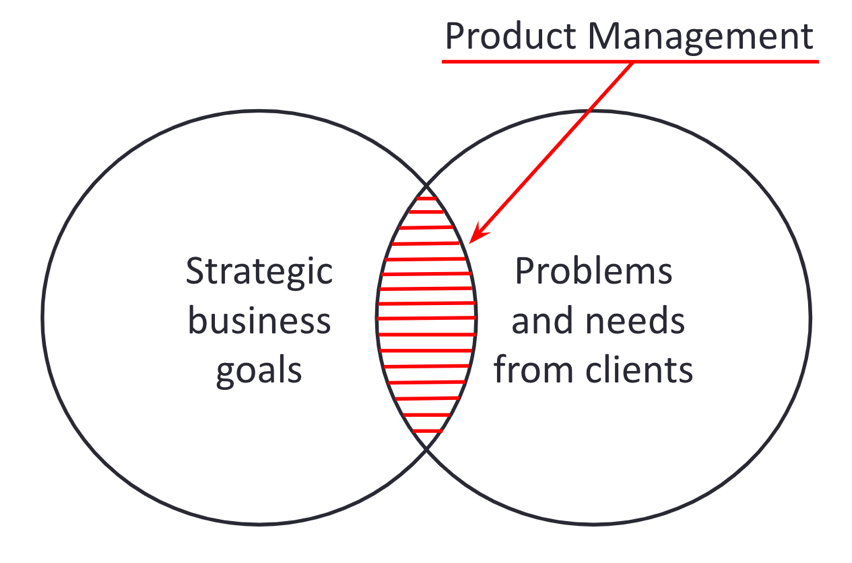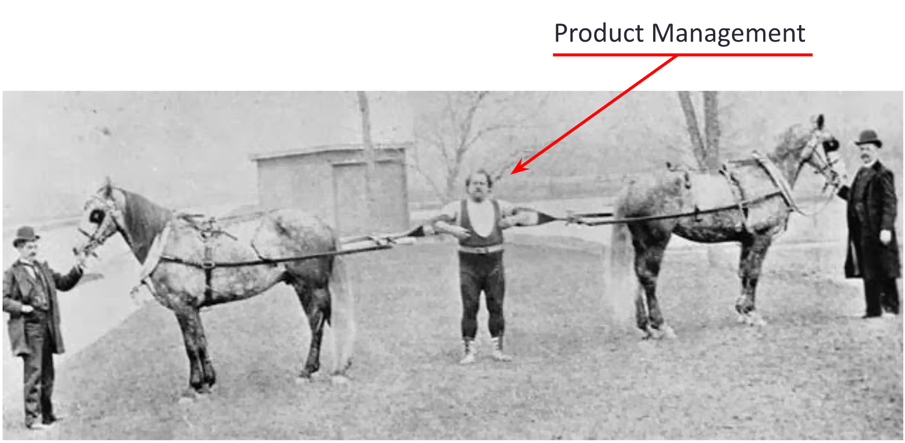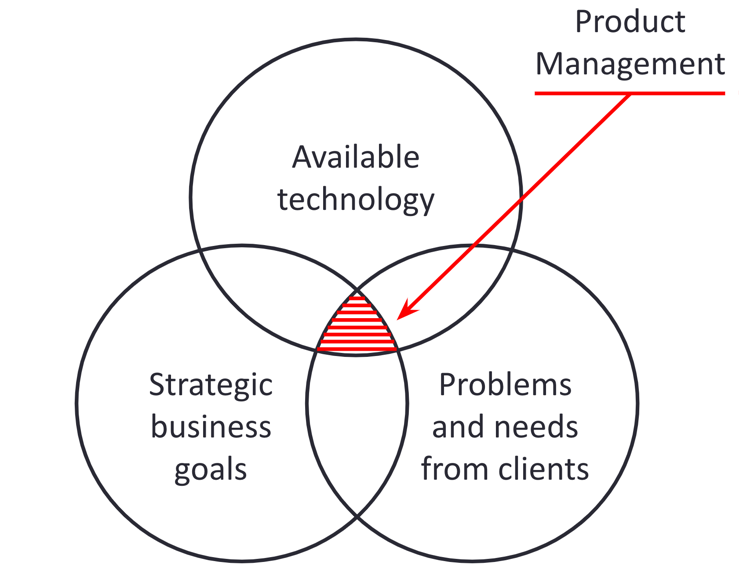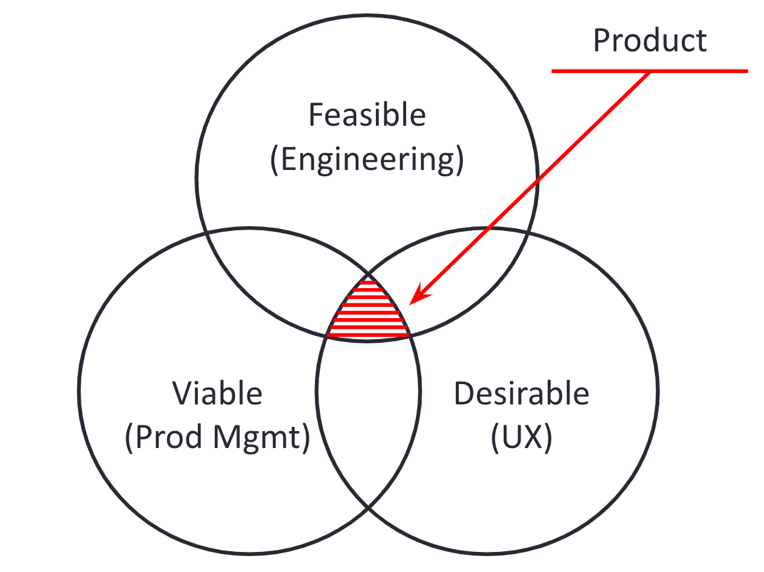What is a digital product?
7 de September, 2021Product manager or product owner?
21 de September, 2021We already have the definition of digital products, we saw many examples and many ways of categorizing these products. We also understood the difference between a product and a platform. Now we are going to define the role of digital product management:
Digital product management is the function responsible for all aspects of a software product, during the whole lifecycle of this product, from its conception to the end of its lifetime.
It is the function responsible for making the connection between the company strategy and the problems and needs of clients using the digital product. This one must be, at the same time, helping the company to accomplish its strategic goals, while solving the problems and needs of clients.
This definition clears up three important points:
- The first one is the responsibility for all the aspects of a digital product. That means that product managers have to worry with the user experience and with the engineering of their product including the architecture, infrastructure and operation. Product managers also have to worry with legal and financial matters, client support, and product marketing and sales.
Worrying about does not mean doing all those things. In your company, there are people and departments dedicated to take care of these themes. Therefore, worrying means understanding these aspects, what are the relations with the product, and how the product impacts in each one of these areas. This will be the subject on Part III – Relation with other areas, in which I’ll approach the connection between software product management and other areas of the company.
- The second point is that the responsibility takes place during the whole lifecycle of the product. As we will see on Part II – Lifecycle of a software product, the lifecycle of a product has different stages and each one of them requires special attention.
- The third point is the connection that product management must build between the company’s strategic goals and the problems and needs of clients, which is what we will see next.
Aligning company strategy with customer needs
The very important third point of defining software product management is the responsibility for guaranteeing the connection between the company strategy and the problems and needs of clients. At the intersection between the business goals and the solution of problems (and needs) of clients lies the digital product management, as we can see in the picture as follows:

This is the theory, and everything seems simple in theory. However, as we all know, practice and theory can be quite different. The real-life digital product management is better illustrated by the picture:

In this image, we see Louis Cyr, considered the strongest man on Earth in 1890, who lifted 227kg using only 3 fingers and 1,967kg on his back!
It better represents the digital product management role because it is not always simple to conciliate the company’s goals and the solution for a problem or need of a client. A simple example is Facebook that, like any other company, needs the revenue to pay its costs and present some return to its investors. That is Facebook’s business goal. On the other hand, we find Facebook’s users, who access the system for free and are not interested in paying for that access.
Facebook’s product manager had to find a way of generating revenue without charging the users. The solution was to find another type of client, the advertisers, who were willing to pay to display ads for the users.
This image is incomplete…
The first image is incomplete. It talks about the company’s strategic goals and about the problems and needs of clients. However, a product manager cannot look just at these two items. There’s a third and very important item, which is the available technology.
The product manager must know the available technology in order to know if it’s possible to solve the client’s problem or need, attending to the company’s strategic goals. See the picture below:

The core team for developing software products
The three concerns we’ve approached previously give us some taste of the ingredients to the product’s success. A successful product must be:
- Desirable: solves problems or fits the needs of clients;
- Viable: meets the company’s strategic goals; and
- Feasible: there’s available technology for developing it.
These three requirements define the essential functions for creating a successful product: designer, product manager, and developer. This trio is considered the core team for developing a digital product and must be very much in sync in every stage of its development.

Viable — what will sustain the business?
Product managers have two main responsibilities: to evaluate the product’s opportunities and to define the products that are going to be built. After evaluating and deciding that the development of the product will pay off, they initiate the phase of discovering exactly how it should be (along with the core team), including the necessary features, the user experience, and the criteria for launching it.
Besides, it is in their hands to determine the business model that is going to be followed, and interacting with practically every other area of the company in order to set up legal matters, accounting, financial, marketing, distribution technicalities, etc.
Desirable — what do people need?
This is where the User Experience (UX) comes in. There are many roles in a UX team, however, the one that works closely with the product manager is the interaction designer. They are responsible for searching for a deep understanding of users, discovering their motivations, behavior, and skills; for helping to define the requirements, thus designing an interface that makes the user interaction with the product as simpler and efficient as possible, while achieving the business goals at the same time.
Feasible — what can we build?
The software engineers or developers are responsible for effectively building the product. Their role is important in the stage of defining the product and clarifying what is possible to be done, the evaluation of costs of different ideas and helping to identify the best feasible solutions. It’s their responsibility to define the most appropriate technology and architecture for developing a quality product.
What is the difference between managing a product and a platform?
Regarding software products, the concern is only with one type of client. In a platform, if it is single-side, besides worrying about understanding one single type of client, it is necessary to understand the relation with him.
But if the platform is multi-sided you should worry about two or more different types of users and the relation between users of the same kind and of different kinds. In other words, the concerns, both from the product manager and from everyone who works in developing the platform, can be more complex than the ones regarding a product with one single kind of client.
A platform strategy must take into account that the client does not perceive value only in the features of the product that are 100% under the company’s control. Aside from the features, the client seeks value in interactions with third parties, and it is the company’s responsibility (the owner of the platform) to manage these relations in order to obtain the best results, both for the participants of the platform and for itself.
New concerns in platform management
Besides all concerns of product management that I’m describing in this book, those who manage platforms must also take into consideration other aspects.
The platform features depend on the participation of users. In English, we use the expression tipping for this concern, i.e., how to attract enough users to a platform so it can be useful for those who participate in it? Some strategies for this are:
- First user: to get a first user who by himself attracts other ones. This is a tactic used by shopping malls when they sign contracts with department stores that by themselves attract enough consumers. Later, you can offer spots to other stores, that will certainly be more interested in being on the mall.
- Social: another way of getting users is to engage on social networks and engines. Something like “tell your friends from Facebook”.
- Leader user: discover what is the user profile that will be strongly attracted by the idea at the point of being the first one to adopt the platform. Bitcoin attracted several people from technology areas initially who fell in love with the idea of a currency not linked to any government, and they defend the idea passionately.
Think about the benefits as a product. The product itself must have enough benefits as a standalone product. Instagram, before the feature of sharing photos, was able to make photos look cool. OpenTable, before the booking feature, was a good ERP (Enterprise Resource Planning) for restaurants.
Consider lowering prices. It is a strategy valid for attracting users, but it is good to remember that it is difficult to raise the price later, especially if you lower it to zero. Sure, you can subsidize it with ads, but you need to know if your users will like those ads and if you are going to get advertisers willing to invest.
There are also features that depend on users’ behavior. In English, the term used for that is coring, i.e. how to guarantee that they are not taking unfair advantage of each other, ensuring that every participant has benefits? Some strategies for taking care of coring:
- Promote trust: auction and online payment sites usually do this, holding up the buyer’s money until he confirms that he received the product sold to him.
- Offer quality information: usually, those user-made ratings. The big risk here is to manage false ratings; or a positive evaluation made by the analyzed person or company, and negative ones made by competitors.
- Restrict the use: turn the subscription and the use more restricted, so that will bring fewer users, but quality ones. That’s what the online dating website eHarmony does. It charges a fairly expensive monthly fee (US$ 50.00) and gives you a very extensive form for you to fill up. In addition, even if its matchmaking algorithm finds several options, it will only present you a limited number in order to ease up the process of choice.
Concluding
It is important to understand if you are working on a product or on a platform because there are some differences in managing each one of them.
A platform needs a strategy for attracting the first users, and this is equally or more important than the features. As software product managers, we tend to get excited with technical features, however, in platforms, the focus is concentrated on users, on their relations, and on how to attract the first users. In addition to that, managing a platform requires control and relation governance inside the platform itself, in order to guarantee that all participants are benefiting from it.
Once we understand what software product management is and what are the differences between managing software and managing platforms, what we need now is to understand what a software product manager is. That’s the subject of our next chapter!
Digital Product Management Books
Do you work with digital products? Do you want to know more about how to manage a digital product to increase its chances of success, solve its user’s problems and achieve the company objectives? Check out my Digital Product Management bundle with my 3 books where I share what I learned during my almost 30 years of experience in creating and managing digital products:
- Startup Guide: How startups and established companies can create profitable digital products
- Product Management: How to increase the chances of success of your digital product
- Leading Product Development: The art and science of managing product teams

